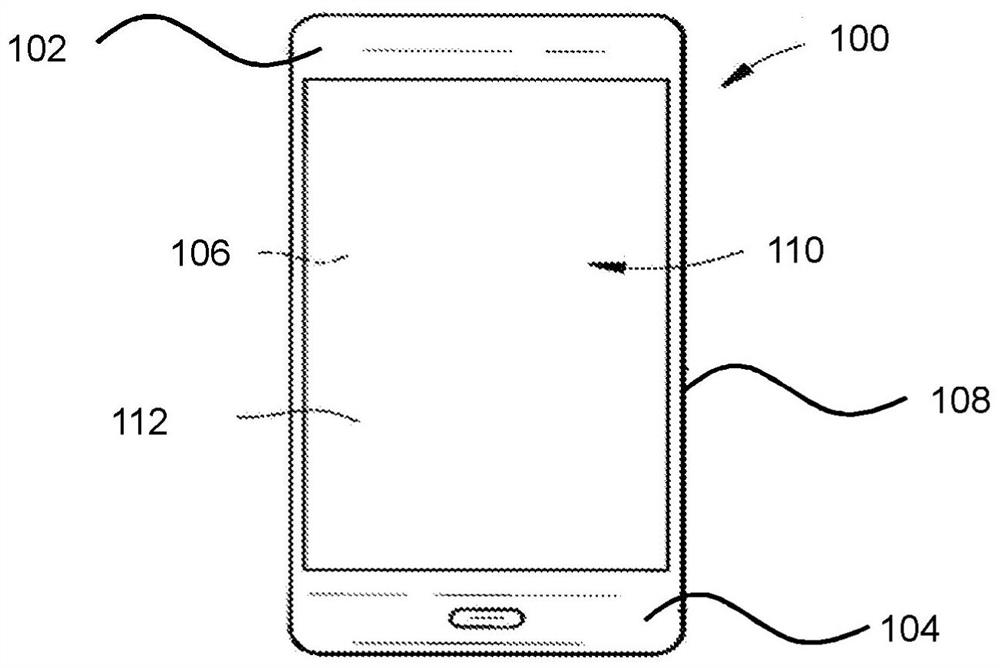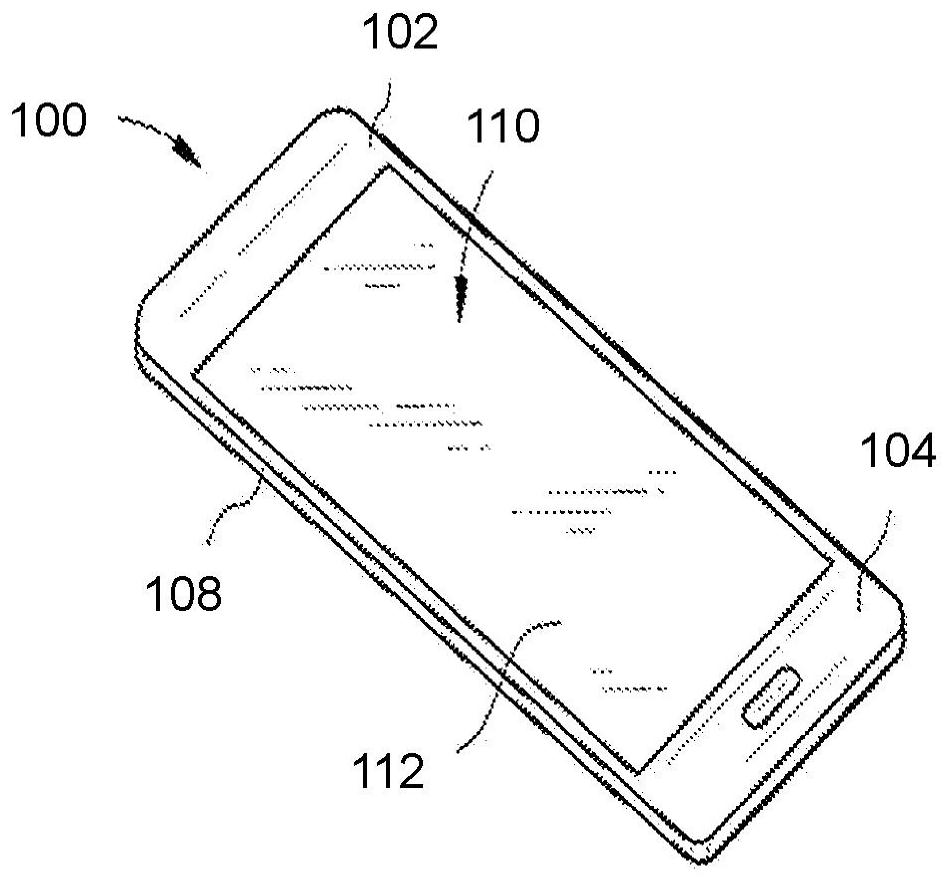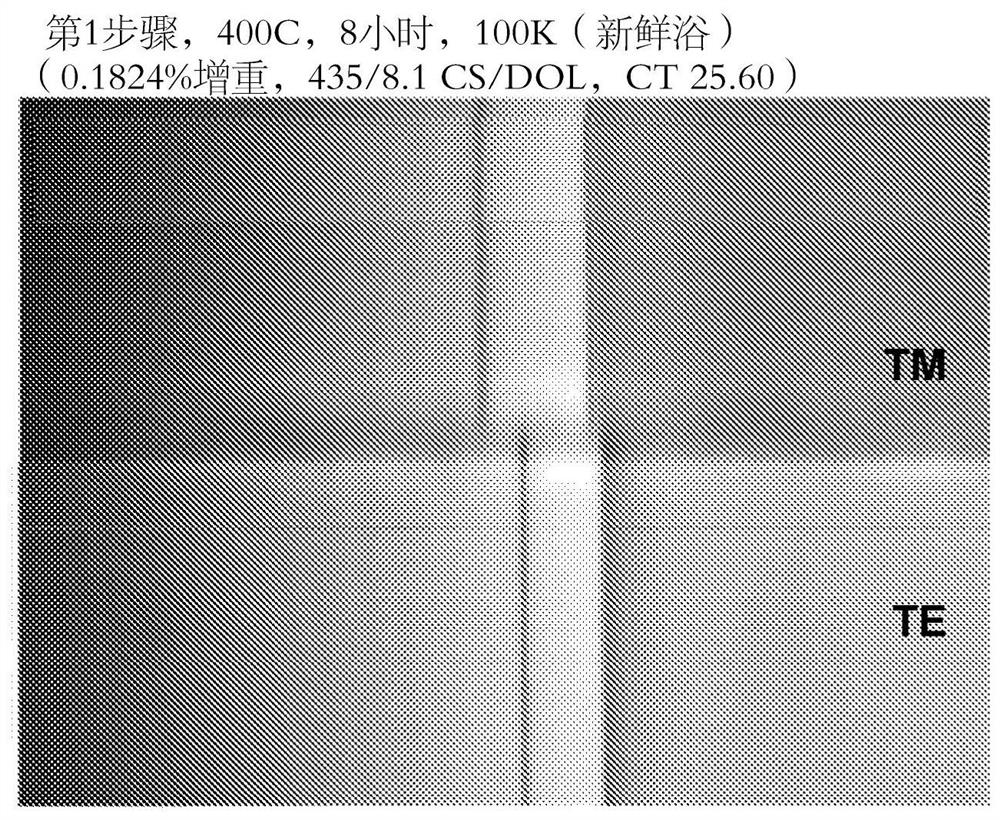Glass-ceramic articles with improved stress profiles
A technology of glass ceramics and stress distribution, applied in the field of glass ceramic products with improved stress distribution, which can solve the problems of slow diffusion
- Summary
- Abstract
- Description
- Claims
- Application Information
AI Technical Summary
Problems solved by technology
Method used
Image
Examples
Embodiment 1
[0146] Glass-ceramic articles were formed from the above-mentioned lithium-based glass-ceramic substrates by a two-step ion exchange treatment.
[0147] The first IOX bath is 100 wt% KNO 3 , and 0.5% by weight (of the bath) of NaNO was added to the bath 2 Dose to improve bath chemistry. 10X at 460°C for 8 hours. After the first IOX with: 0.1824% weight gain, 435 MPa compressive stress (CS), depth of layer (DOL) for K 8.1 microns (depth of inflection point), 25.60 MPa maximum central tension (CT). figure 2 are images of TM and TE guided mode spectral fringes after the first 10X treatment.
[0148] The substrate is then exposed to a second 10× bath, which is 90% by weight KNO 3 and 10 wt% NaNO 3 , and contains (of the bath) 0.5% by weight of NaNO 2 dose. The second 10X was at 430°C for 8 hours. Has: 0.3463% weight gain, 339 MPa CS, DOL for K 9.4 microns, 39.75 MPa maximum central tension (CT). image 3 are images of the TM and TE guided mode spectral fringes of the res...
Embodiment 2
[0150] Glass-ceramic articles were formed from the above-mentioned lithium-based glass-ceramic substrates by a two-step ion exchange process in the presence of lithium in the IOX process.
[0151] The first IOX bath is 100 wt% KNO 3 , to which 0.02% by weight (of the bath) of LiNO was added 3 Dose and 0.5 wt% NaNO 2 dose. The first 10X was at 460°C for 8 hours. Has a 0.1219% weight gain and a CT of 17.36 MPa. Figure 4 are images of TM and TE guided mode spectral fringes after the first 10X treatment.
[0152] The substrate is then exposed to a second 10× bath, which is 90% by weight KNO 3 and 10 wt% NaNO 3 , to which 0.02 wt% (of the bath) of LiNO was added 3 Dose and 0.5 wt% NaNO 2 dose. The second 10X was at 430°C for 8 hours. Has a 0.3587% weight gain and a CT of 45.78 MPa. Figure 5 are images of the TM and TE guided mode spectral fringes of the resulting glass-ceramic article. There are two stripes, which enable proper process control over bath composition, b...
Embodiment 3
[0154] Glass-ceramic articles were formed from the above-mentioned lithium-based glass-ceramic substrates by a two-step ion exchange process in the presence of lithium in the IOX process.
[0155] The first IOX bath is 100 wt% KNO 3 , to which 0.02% by weight (of the bath) of LiNO was added 3 Dose and 0.5 wt% NaNO 2 dose. The first 10X was at 460°C for 8 hours. Has a CT of 15.97MPa. Figure 6 are images of TM and TE guided mode spectral fringes after the first 10X treatment. Figure 7 is the resulting stress profile (stress (MPa) vs. position (microns) plot) after the first 10× treatment for half the substrate thickness. exist Figure 7 , notice the presence of spikes.
[0156] The substrate is then exposed to a second 10× bath, which is 90% by weight KNO 3 and 10 wt% NaNO 3 , to which 0.02 wt% (of the bath) of LiNO was added 3 Dose and 0.5 wt% NaNO 2 dose. The second 10X was at 460°C for 10 hours. Has a CS of 303 MPa, a potassium DOL (depth of inflection point) o...
PUM
| Property | Measurement | Unit |
|---|---|---|
| compressive stress | aaaaa | aaaaa |
| thickness | aaaaa | aaaaa |
| compressive stress | aaaaa | aaaaa |
Abstract
Description
Claims
Application Information
 Login to View More
Login to View More - R&D
- Intellectual Property
- Life Sciences
- Materials
- Tech Scout
- Unparalleled Data Quality
- Higher Quality Content
- 60% Fewer Hallucinations
Browse by: Latest US Patents, China's latest patents, Technical Efficacy Thesaurus, Application Domain, Technology Topic, Popular Technical Reports.
© 2025 PatSnap. All rights reserved.Legal|Privacy policy|Modern Slavery Act Transparency Statement|Sitemap|About US| Contact US: help@patsnap.com



